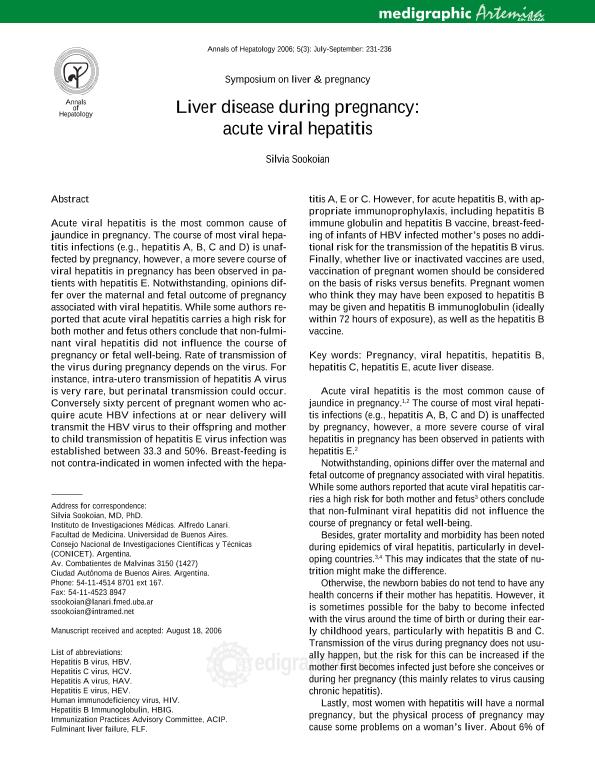Mostrar el registro sencillo del ítem
dc.contributor.author
Sookoian, Silvia Cristina

dc.date.available
2020-06-17T19:40:16Z
dc.date.issued
2006-07
dc.identifier.citation
Sookoian, Silvia Cristina; Liver disease during pregnancy: acute viral hepatitis; Mexican Association of Hepatology; Annals of Hepatology; 5; 3; 7-2006; 231-236
dc.identifier.issn
1665-2681
dc.identifier.uri
http://hdl.handle.net/11336/107564
dc.description.abstract
Acute viral hepatitis is the most common cause of jaundice in pregnancy. The course of most viral hepatitis infections (e.g., hepatitis A, B, C and D) is unaffected by pregnancy, however, a more severe course of viral hepatitis in pregnancy has been observed in patients with hepatitis E. Notwithstanding, opinions differ over the maternal and fetal outcome of pregnancy associated with viral hepatitis. While some authors reported that acute viral hepatitis carries a high risk for both mother and fetus others conclude that non-fulminant viral hepatitis did not influence the course of pregnancy or fetal well-being. Rate of transmission of the virus during pregnancy depends on the virus. For instance, intra-utero transmission of hepatitis A virus is very rare, but perinatal transmission could occur. Conversely sixty percent of pregnant women who acquire acute HBV infections at or near delivery will transmit the HBV virus to their offspring and mother to child transmission of hepatitis E virus infection was established between 33.3 and 50%. Breast-feeding is not contra-indicated in women infected with the hepa-titis A, E or C. However, for acute hepatitis B, with appropriate immunoprophylaxis, including hepatitis B immune globulin and hepatitis B vaccine, breast-feeding of infants of HBV infected mother's poses no additional risk for the transmission of the hepatitis B virus. Finally, whether live or inactivated vaccines are used, vaccination of pregnant women should be considered on the basis of risks versus benefits. Pregnant women who think they may have been exposed to hepatitis B may be given and hepatitis B immunoglobulin (ideally within 72 hours of exposure), as well as the hepatitis B vaccine.
dc.format
application/pdf
dc.language.iso
eng
dc.publisher
Mexican Association of Hepatology

dc.rights
info:eu-repo/semantics/openAccess
dc.rights.uri
https://creativecommons.org/licenses/by-nc-nd/2.5/ar/
dc.subject
Pregnancy
dc.subject
viral hepatitis
dc.subject
hepatitis B
dc.subject
hepatitis C
dc.subject
hepatitis E
dc.subject
acute liver disease
dc.subject.classification
Medicina General e Interna

dc.subject.classification
Medicina Clínica

dc.subject.classification
CIENCIAS MÉDICAS Y DE LA SALUD

dc.title
Liver disease during pregnancy: acute viral hepatitis
dc.type
info:eu-repo/semantics/article
dc.type
info:ar-repo/semantics/artículo
dc.type
info:eu-repo/semantics/publishedVersion
dc.date.updated
2020-05-27T16:41:07Z
dc.journal.volume
5
dc.journal.number
3
dc.journal.pagination
231-236
dc.journal.pais
México

dc.journal.ciudad
Mexico, DF.
dc.description.fil
Fil: Sookoian, Silvia Cristina. Consejo Nacional de Investigaciones Científicas y Técnicas. Oficina de Coordinación Administrativa Houssay. Instituto de Investigaciones Médicas. Universidad de Buenos Aires. Facultad de Medicina. Instituto de Investigaciones Médicas; Argentina
dc.journal.title
Annals of Hepatology

dc.relation.alternativeid
info:eu-repo/semantics/altIdentifier/url/https://www.elsevier.es/en-revista-annals-hepatology-16-articulo-liver-disease-during-pregnancy-acute-S1665268119320198
dc.relation.alternativeid
info:eu-repo/semantics/altIdentifier/doi/http://dx.doi.org/10.1016/S1665-2681(19)32019-8
Archivos asociados
